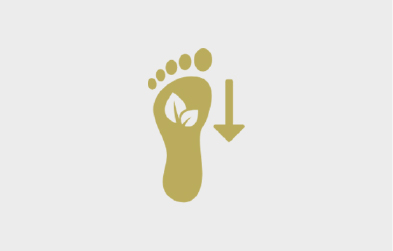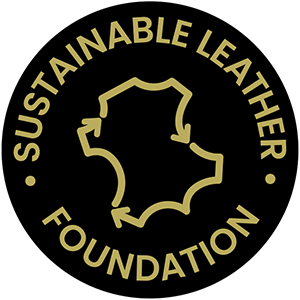Carbon Footprint

At the Sustainable Leather Foundation carbon footprint falls under all three of the domains of the ESG sustainability, planet. Mainly because planet and people are the most affected by carbon emissions and the effects it has on the climate and the communities affected by climate change. Although the planet and people dominate thinking on climate change the markets also currently require new products that help individuals lower their carbon footprint.
The Foundation works collaboratively with chemical suppliers, machinery companies, other certification bodies, value chain facilities and consumers to ensure that leathers made in the industry contain chemistry that assists in lowering the environmental footprint and in general improves the circular economy.
It all starts with the separation of the hide/skin from the life cycle of the animal – the hide/skin is a by-product of the meat industry. With that separation the hide/skin inherits some of the animal’s footprint and then increases its footprint from there. Each step adds environmental footprint until it lands in the hands of the final consumer – even the transportation by the retailer. The final consumer further increases that product’s footprint by adding energy, water and chemicals. If the product is disposed of its final footprint contribution will be to the environment in its end-of-life.
The farmer, industry, retailer and consumer thus have a commitment to think about the impacts their choices make. Continuously lowering the impacts and choosing materials that are lower impacts (in all areas of the production, use and end-of-life stages). Most materials focus on the production stage, whilst we believe the focus should be looking at all three.
A collaborative approach with the industry to allow producers, retailers and consumers to consistently consider leathers that contribute to lower environmental footprints is key. Together with our value chain partners, the Foundation has worked with stakeholders to provide accountability of carbon footprint terms in the Pathway Papers and in the Carbon Footprint Collaboration Hub.
Life-cycle analysis of all parts of the value chain (including all the ingredients) is thus required. Each step, each ingredient (and machine) and the water and energy used widen the footprint and their necessity should be questioned.
Low footprint farming and processing is the present and future focus of the Foundation.
At the Sustainable Leather Foundation carbon footprint falls under all three of the domains of the ESG sustainability, planet. Mainly because planet and people are the most affected by carbon emissions and the effects it has on the climate and the communities affected by climate change. Although the planet and people dominate thinking on climate change the markets also currently require new products that help individuals lower their carbon footprint.
The Foundation works collaboratively with chemical suppliers, machinery companies, other certification bodies, value chain facilities and consumers to ensure that leathers made in the industry contain chemistry that assists in lowering the environmental footprint and in general improves the circular economy.
It all starts with the separation of the hide/skin from the life cycle of the animal – the hide/skin is a by-product of the meat industry. With that separation the hide/skin inherits some of the animal’s footprint and then increases its footprint from there. Each step adds environmental footprint until it lands in the hands of the final consumer – even the transportation by the retailer. The final consumer further increases that product’s footprint by adding energy, water and chemicals. If the product is disposed of its final footprint contribution will be to the environment in its end-of-life.
The farmer, industry, retailer and consumer thus have a commitment to think about the impacts their choices make. Continuously lowering the impacts and choosing materials that are lower impacts (in all areas of the production, use and end-of-life stages). Most materials focus on the production stage, whilst we believe the focus should be looking at all three.
A collaborative approach with the industry to allow producers, retailers and consumers to consistently consider leathers that contribute to lower environmental footprints is key. Together with our value chain partners, the Foundation has worked with stakeholders to provide accountability of carbon footprint terms in the Pathway Papers and in the Carbon Footprint Collaboration Hub.
Life-cycle analysis of all parts of the value chain (including all the ingredients) is thus required. Each step, each ingredient (and machine) and the water and energy used widen the footprint and their necessity should be questioned.
Low footprint farming and processing is the present and future focus of the Foundation.
Get Involved
Get Involved
The SLF Collaboration Hubs and the Technical Focus Groups of the Advisory Board are the main platforms for stakeholder engagement with the industry partners. There is a great deal of modern, best practices regarding environmental footprints of processing already being used in the industry – but there is aspiration for more. Momentum is growing in the industry to ensure that even better techniques continue to evolve – with leather leading the way in many areas.
In the discussion forums mentioned above, the industry helps to identify the priorities, and through democratic, transparent negotiations, decides the solutions to those priorities (in a pre-competitive space). The Foundation helps partners to then implement the best practices into their facilities.
We have been producing independently peer reviewed papers since 2020 and work with industry experts to ensure that these leading ideas are found within the Foundation’s Audit Standard and supporting documents. The continuous engagement with the content shows a serious commitment to corporate responsibility and sustainability.
Carbon Footprint:
The SLF and industry attitude towards the due diligence on processing is aligned with the United Nations Framework Convention on Climate Change (UNFCCC) and the Intergovernmental Panel on Climate Change (IPCC).
The Foundation provides climate actions as follows:
- Collaborates and publishes knowledge on climate change and environmental footprints
- Monitors global developments on environmental footprints
- Informs the community on the best available information on environmental footprints and the effects they have on the environment and the climate
- Discusses the pros and cons of processes that impact the environment more
- Publishes benchmarks and standards on carbon footprint and how they could be measured
- Asks facilities to consider increasing their footprint.
The SLF Collaboration Hubs and the Technical Focus Groups of the Advisory Board are the main platforms for stakeholder engagement with the industry partners. There is a great deal of modern, best practices regarding environmental footprints of processing already being used in the industry – but there is aspiration for more. Momentum is growing in the industry to ensure that even better techniques continue to evolve – with leather leading the way in many areas.
In the discussion forums mentioned above, the industry helps to identify the priorities, and through democratic, transparent negotiations, decides the solutions to those priorities (in a pre-competitive space). The Foundation helps partners to then implement the best practices into their facilities.
We have been producing independently peer reviewed papers since 2020 and work with industry experts to ensure that these leading ideas are found within the Foundation’s Audit Standard and supporting documents. The continuous engagement with the content shows a serious commitment to corporate responsibility and sustainability.
Carbon Footprint:
The SLF and industry attitude towards the due diligence on processing is aligned with the United Nations Framework Convention on Climate Change (UNFCCC) and the Intergovernmental Panel on Climate Change (IPCC).
The Foundation provides climate actions as follows:
- Collaborates and publishes knowledge on climate change and environmental footprints
- Monitors global developments on environmental footprints
- Informs the community on the best available information on environmental footprints and the effects they have on the environment and the climate
- Discusses the pros and cons of processes that impact the environment more
- Publishes benchmarks and standards on carbon footprint and how they could be measured
- Asks facilities to consider increasing their footprint.
Biodegradability at a glance:

Biodegradability at a glance:
